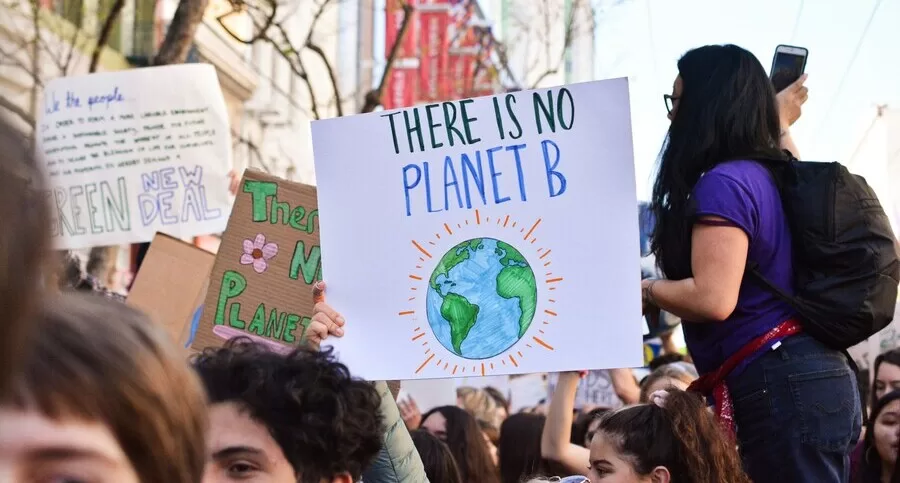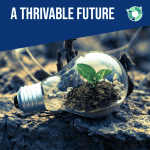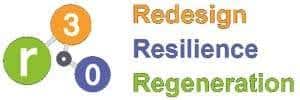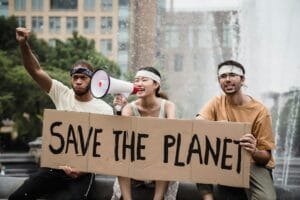A thrivable lifestyle presents a transformative alternative to conventional sustainability approaches, as climate change continues to disrupt ecosystems, economies, and daily life across the globe. Its effects are profound and accelerating on every continent. Unlike sustainability, which focuses on reducing harm, a thrivable lifestyle emphasises regeneration, creativity, and co-flourishing across all life systems. It promotes life-enhancing frameworks that evolve, adapt, and renew rather than merely sustain (Delaney & Madigan, 2021). Importantly, the climate crisis is not only ecological, but also challenges cultures, economies, and health systems worldwide.
This expanded vision aligns with the THRIVE Framework’s emphasis on Integral Thinking, which integrates ecological, cultural, and social dimensions alongside economic concerns. Rather than prioritising single-capital economic growth, thrivability values a Multi-Capital Approach that considers human, natural, and social well-being as essential to long-term resilience.

Source: Li-An Lim on Unsplash, March 16, 2019
Understanding Thrivability: Beyond Sustainability
From Sustainability to Regeneration
The concept of thrivability represents a paradigm shift from conventional sustainability toward more dynamic, regenerative approaches to development. While sustainability typically focuses on minimising harm and maintaining systems within planetary boundaries, thrivability emphasises proactive regeneration, systemic flourishing, and long-term co-evolution with nature (Laszlo et al., 2022).
Recent studies suggest that sustainability, particularly as framed by the UN’s Sustainable Development Goals (SDGs), is often limited to risk mitigation and resource efficiency (Voulvoulis et al., 2022). Although these goals are important, they may fall short of delivering the deep transformation needed to address today’s interconnected planetary crises.
A Systems-Based, Regenerative Perspective
In contrast, thrivability is grounded in Systems Thinking, which recognises the complex interdependence between ecological, social, economic, and cultural systems. Rather than simply reducing harm, thrivability encourages conditions that allow life to adapt, evolve, and co-flourish (Vetter et al., 2020). This regenerative lens includes practices such as rebuilding soil health, restoring biodiversity, reviving community cohesion, and reimagining economic systems. It moves beyond carbon neutrality to actively support ecological vitality (Singh & Chudasama, 2021).
What Does a Thrivable Lifestyle Look Like?
A thrivable lifestyle envisions more than survival. It means:
- Easy access to clean air and water
- Proximity to rejuvenating natural ecosystems
- The ability to live a healthy, balanced life through relaxation, movement, and wholesome natural foods
- A culture of care, reciprocity, and well-being—socially, physically, and environmentally
It is about living in a way that enhances life’s quality without depleting the very systems that sustain it.
When Climate Change Disrupts Thrivability
Climate change is undermining the foundations of everyday life. On a personal level, its impacts are already reshaping daily habits once taken for granted. In many places, record-breaking heatwaves have made walking or cycling unviable. What were once short walks to public transit are now replaced by cab rides to escape the extreme sun. Air conditioning runs longer to ensure homes, offices, and shops are functioning spaces. Outdoor exercise is restricted. Reliable transport networks buckle during flash floods. These are not minor inconveniences. They are early signs of systemic strain, illustrating just how quickly a thrivable lifestyle can unravel under climate stress.
Post-Sustainability: A Transformative Shift
The post-sustainability movement, which has grown in academic and policy circles, emphasises that humanity must move beyond metrics and compliance to embrace transformative well-being, planetary care, and cultural renewal (Prescott, 2024). In practice, thrivability frameworks promote agency, co-creation, and values-based action, calling for an integration of Indigenous knowledge, ecological ethics, and participatory governance.
These changes reflect the THRIVE focus on Integral Thinking and Strong Sustainability, both of which reject the notion that economic capital can substitute for natural systems. Instead, thrivability promotes the protection and regeneration of irreplaceable ecological and cultural assets, laying the foundation for truly resilient futures.

Source: Matt Palmer on Unsplash, August 4, 2021
Climate Change Threats to a Thrivable Future
The current pace and scale of climate change pose a grave threat to the foundations of a thrivable lifestyle. From extreme weather to social fragmentation, its environmental impact undermines both natural systems and human resilience (Loucks, 2021).
Rising Temperatures and Health
Climate change intensifies heatwaves, floods, and storms, directly affecting public health. Vulnerable populations, particularly in urban slums and aging societies, face increased risks of heatstroke, respiratory illness, and vector-borne diseases (Soomro et al., 2025). As ecosystems shift, planetary health becomes increasingly fragile, and healthcare systems struggle to keep pace.
Resource Scarcity
Depletion of water, soil fertility, and biodiversity is disrupting food systems and daily living. These forms of ecological stress jeopardise ecological balance and contribute to growing insecurity. In many regions, climate-induced droughts or floods push rural populations toward cities, straining urban infrastructure and housing (Almulhim et al., 2024).
Here, the focus on Materiality provides a lens to prioritise such risks, not only as environmental concerns but also as socio-economic and governance challenges.
Inequality and Social Erosion
Climate change compounds inequality. Those least responsible for carbon emissions, such as Indigenous communities and small island nations, often face the worst consequences (Parsons et al., 2024). This dynamic erodes social trust and undermines the social fabric necessary for resilient futures.
Mental Health and Cultural Loss
For many, especially youth, climate change generates deep emotional distress. Feelings of helplessness, eco-anxiety, and grief are widespread. Meanwhile, as traditional livelihoods and landscapes vanish, cultural heritage and identity are put at risk (Pearson et al., 2021). The resulting trauma challenges not just well-being but the very narrative of thriving.

Source: Mike Erskine on Unsplash, June 28, 2020
Urban Transformation as a Path to Thrivability
Modern urban development must prioritise both infrastructure modernisation and human-centred regeneration. This dual focus is vital for enhancing the well-being of urban populations. Resilience—spanning environmental integrity, economic stability, social equity, and adaptive governance—forms the backbone of future-ready cities. Resilient urban systems are characterised by their capacity to absorb, adapt to, and recover from a wide range of disturbances, whether ecological or anthropogenic (Allan et al., 2024).
Green Infrastructure
Cities can reduce heat, absorb floods, and store carbon through trees, wetlands, and green rooftops (Riffat et al., 2024). These nature-based solutions support ecological balance while improving urban life. Importantly, they also reconnect people with nature (Lehmann, 2023).
Participatory Design and Planning
Resilient urban development increasingly relies on participatory approaches that empower citizens to actively shape their environments. Inclusive engagement ensures that urban solutions reflect the lived experiences and needs of diverse communities. This participatory ethic not only strengthens social cohesion but also advances cultural transformation by amplifying marginalised voices and promoting shared responsibility. As such, collaborative governance becomes a key mechanism for building adaptive, socially inclusive, and technologically resilient urban systems (Bokolo, 2023).
Regenerative Infrastructure
Thrivable cities build for people and the planet. Smart grids, energy-efficient buildings, and water reuse help regenerate natural cycles (Munonye & Ajonye, 2025). Designing infrastructure this way reflects Systems Thinking in action.

Source: Matt Palmer on Unsplash, March 6, 2021
Shifting Values and Behaviors Toward Regeneration
Climate change necessitates more than technological solutions; it calls for deep cultural shifts toward regenerative living and conscious consumption. Addressing overconsumption at its root, rather than mitigating its downstream effects, offers a more thrivable path forward. Encouraging individuals to critically reflect on their roles as consumers can provoke broader social dialogue, potentially catalysing behavioural shifts that support planetary health and long-term resilience (Covarrubias, 2024).
Rethinking Consumption
Linear economies produce waste. A thrivable lifestyle values repair, reuse, and local sourcing. Circular models replace extraction with regeneration. This shift reduces emissions and builds local resilience. This aligns with the Multi-Capital Approach, which calls for the evaluation of economic models through multi-capital performance, not GDP alone.
Education as a Catalyst
Learning transforms. Education rooted in holistic well-being and ecological consciousness prepares people to act. It also cultivates imagination, responsibility, and hope. Art, stories, and nature-based learning reshape climate narratives toward thriving (Sezen-Barrie et al., 2025).
Indigenous Wisdom and Local Knowledge
Many indigenous cultures already live regeneratively. Their knowledge offers tested models of climate adaptation and stewardship. These practices are often undervalued in formal systems. Yet they are essential for resilient futures. Respect and integration of such knowledge reflect true cultural evolution.

Source: NOAA on Unsplash, February 18, 2020
Global Examples of Thrivable Living in Action
Importantly, real-world examples demonstrate that thrivable lifestyles are not abstract ideals; they are already emerging in diverse, tangible ways across the globe. These living models of regeneration, equity, and ecological integration provide concrete proof that thriving communities are both possible and already in motion.
Bhutan
Bhutan offers a compelling example of national policy guided by Gross National Happiness, a holistic framework that prioritises not only economic stability but also cultural preservation, environmental integrity, and emotional well-being. Unlike conventional Gross Domestic Product metrics, this approach reflects a deeper commitment to planetary health and holistic well-being, aligning governance with ecological and human flourishing.
Curitiba, Brazil
Curitiba’s integrated approach to public transport, waste management, and green urban design positions it as a leading global example of urban planning informed by Systems Thinking.
Totnes, UK
Totnes plays a pioneering role in the global Transition Towns movement, which emerged as a grassroots response to climate change and economic instability. One notable initiative is the Totnes Pound, a local currency designed to keep money circulating within the community, supporting independent businesses and reducing reliance on global financial systems. Alongside this, projects like Incredible Edible Totnes transform unused public spaces into community food gardens, encouraging local food production and ecological education. These initiatives promote food sovereignty, circular economies, and citizen-led governance. In doing so, Totnes exemplifies a town transitioning toward resilient, low-carbon, and community-centred systems. These efforts foster both environmental regeneration and social cohesion—key elements of a thrivable lifestyle.
Nairobi, Kenya
In Nairobi, rooftop gardens and youth-led composting projects regenerate land and livelihoods. These initiatives align with green lifestyle values and climate resilience (Mbugua, 2025).
Indigenous Amazon Stewardship
Cofán, Siona, and Siekopai communities in the western Amazon steward forests through relational practices with yoco (Paullinia yoco), a sacred vine traditionally used as a stimulant and ceremonial beverage. Yoco contains natural caffeine and is consumed during communal rituals, often before dawn, to promote alertness, connection, and reflection. Its careful cultivation and respectful harvest exemplify the community’s deep reciprocal relationship with the forest. These practices integrate cultural revitalisation, ecological care, and territorial defence, reinforcing identity while preserving forest ecosystems. As a result, these traditions support biodiversity, carbon sequestration, and future resilience, all rooted in reciprocity and an ecological worldview (Correia et al., 2025).

Source: Markus Spiske on Unsplash, October 3, 2019
Conclusion: Reframing Climate Change as a Catalyst for Flourishing
Climate change is more than a crisis; it is a global turning point that invites deep reflection and bold transformation. While its environmental impact is severe, it also opens the door to reimagining how life can flourish. Embracing a thrivable lifestyle means moving beyond crisis management toward regenerative living that supports both people and the planet.
This shift requires a foundation in Systems Thinking and the understanding that all human activity is part of larger socio-ecological systems. A thriving future depends not on isolated solutions but on integrated responses rooted in ecological balance, planetary health, and long-term climate resilience.
Unlike traditional models of sustainability, post-sustainability approaches prioritise transformation over preservation. A thrivable lifestyle offers not only climate adaptation but also a cultural reawakening centred on holistic well-being, justice, and renewal. It promotes sustainable behaviour change, informed by ecological consciousness and guided by nature-based solutions that restore, rather than deplete, life systems.
Flourishing communities around the world are already living these values, adopting green lifestyles, nurturing local ecosystems, and co-creating resilient futures. These efforts demonstrate that thrivability is not a distant ideal but a practical, hopeful path forward.
In this way, climate change becomes a catalyst, not just for survival, but for the evolution of a new paradigm. One where Strong Sustainability aligns with culture, ecology, and innovation. One where life does not simply endure, but thrives.
Achieving THRIVE goals
The Sustainable Development Goals (SDGs) were designed to address global challenges like poverty, inequality, and climate change. However, their approach often emphasises technical solutions, fragmented targets, and economic metrics. In contrast, the THRIVE Framework offers a more integrated model rooted in Systems Thinking, Integral Thinking, and Strong Sustainability. This framework shifts from mitigation and efficiency toward regeneration, co-creation, and ecological consciousness.
SDG13: Climate Action focuses on reducing emissions and adapting to climate risks. While essential, this often prioritises compliance and technological fixes. THRIVE reframes climate action as an opportunity for co-evolution with nature, emphasising local adaptation, biodiversity restoration, and cultural resilience. Climate strategies are grounded in holistic well-being, not just carbon accounting.
SDG9: Industry, Innovation, and Infrastructure promotes resilient infrastructure and sustainable cities, but often through growth-driven, efficiency-focused planning. THRIVE shifts focus to a Regenerative Economy, systems that support life, restore ecosystems, and enhance human dignity. Cities become spaces for community healing, ecological renewal, and participatory governance.
While SDG11: Sustainable Cities and Communities applies global metrics, it can overlook cultural diversity and local priorities. THRIVE advances smart, localised communities as agents of global change. Guided by Materiality and the Multi-Capital Approach, these communities co-create solutions aligned with their specific needs and values.
A Thrivable Framework
Building a future where both people and the planet thrive requires a shift from fragmented solutions to deeply interconnected thinking. Among the 12 Foundational Focus Factors of the THRIVE Framework, Integral Thinking, Systems Thinking, and Strong Sustainability offer particularly valuable lenses for addressing the complex challenges of climate resilience and regenerative development.
- Integral Thinking bridges environmental, cultural, and social priorities, moving beyond linear goals to foster holistic, life-aligned decision-making. It encourages communities, institutions, and governments to embrace complexity and co-create flourishing futures.
- Systems Thinking highlights the relationships between climate, health, economy, and behaviour. It supports solutions that address root causes, such as urban inequality or ecosystem collapse, through regenerative design, participatory governance, and cross-sector innovation.
- Strong Sustainability rejects the idea that economic growth can substitute for natural systems. Instead, it prioritises the protection and restoration of irreplaceable ecological assets.
Together, these focus factors provide a values-driven, future-oriented framework that enables true thrivable living in the face of climate disruption. At THRIVE, sustainability and healthcare are viewed not as endpoints but as foundations for deeper systemic transformation.
Through ongoing research, education, and public engagement, the organisation explores pathways that move beyond sustainability toward truly thriving systems. Articles, podcasts, and webinars offer insights from thought leaders across disciplines, while the newsletter provides timely updates on regenerative innovation and integrated solutions. The THRIVE community brings together changemakers committed to shaping a future where both people and the planet can flourish, a future defined by thrivability.























